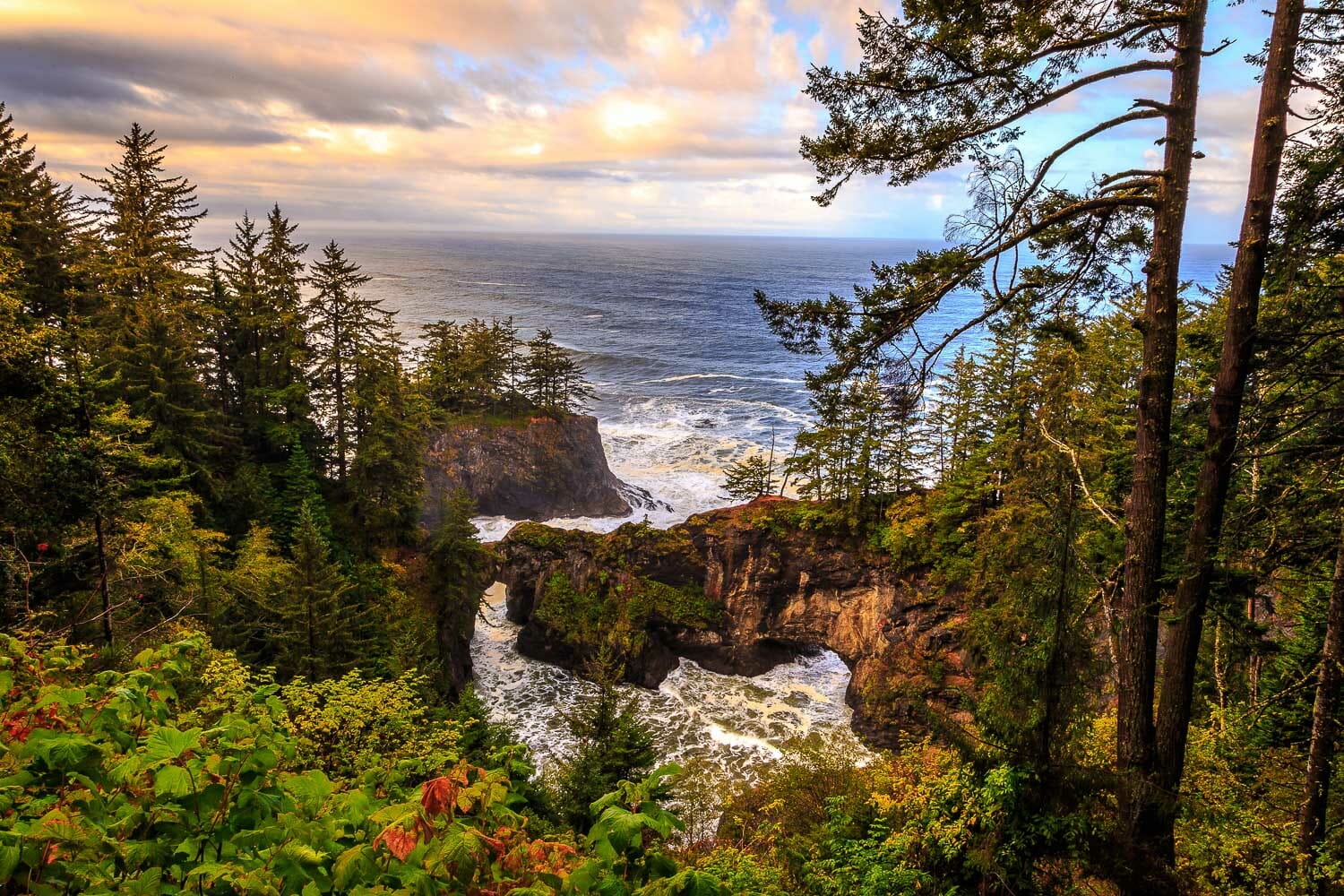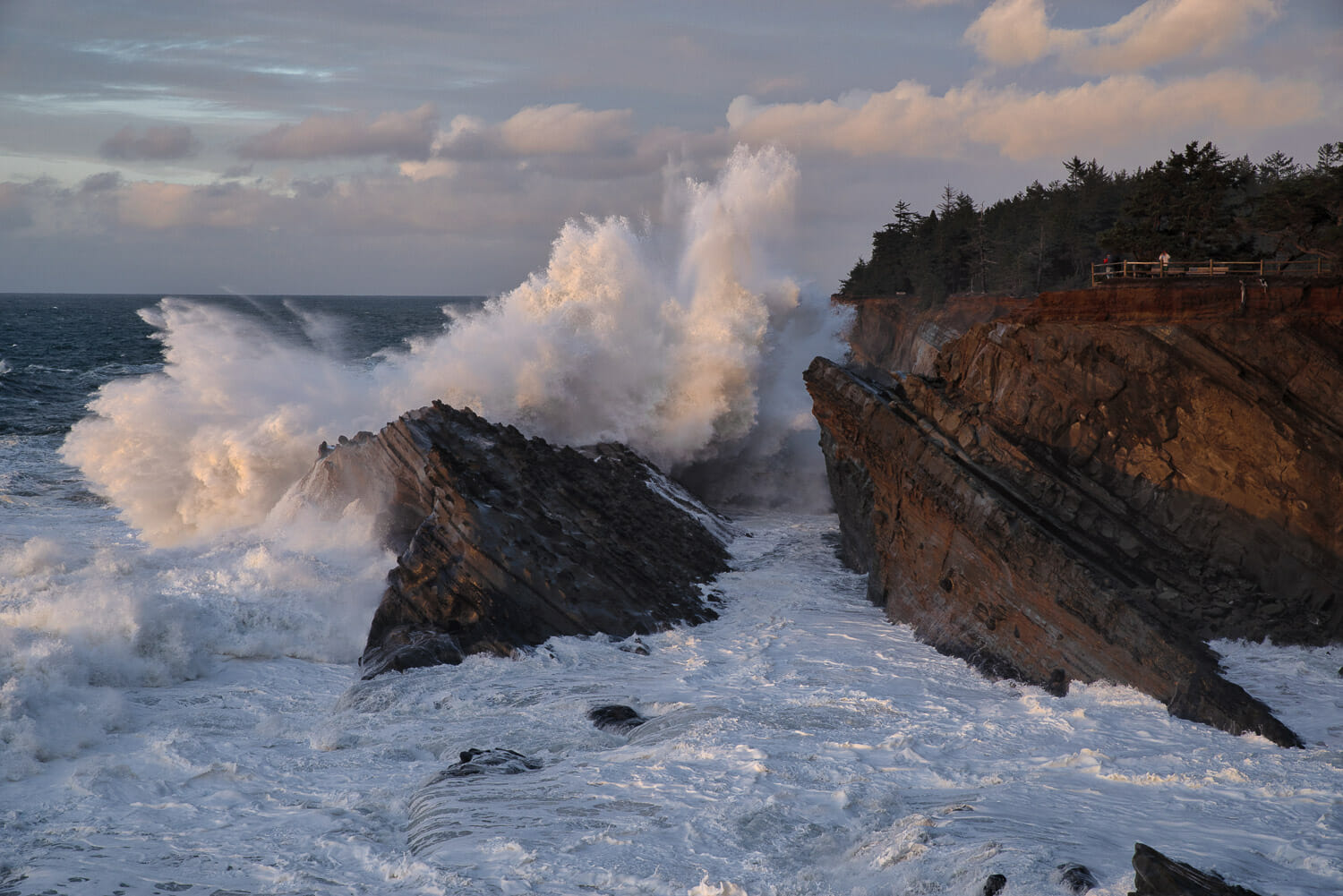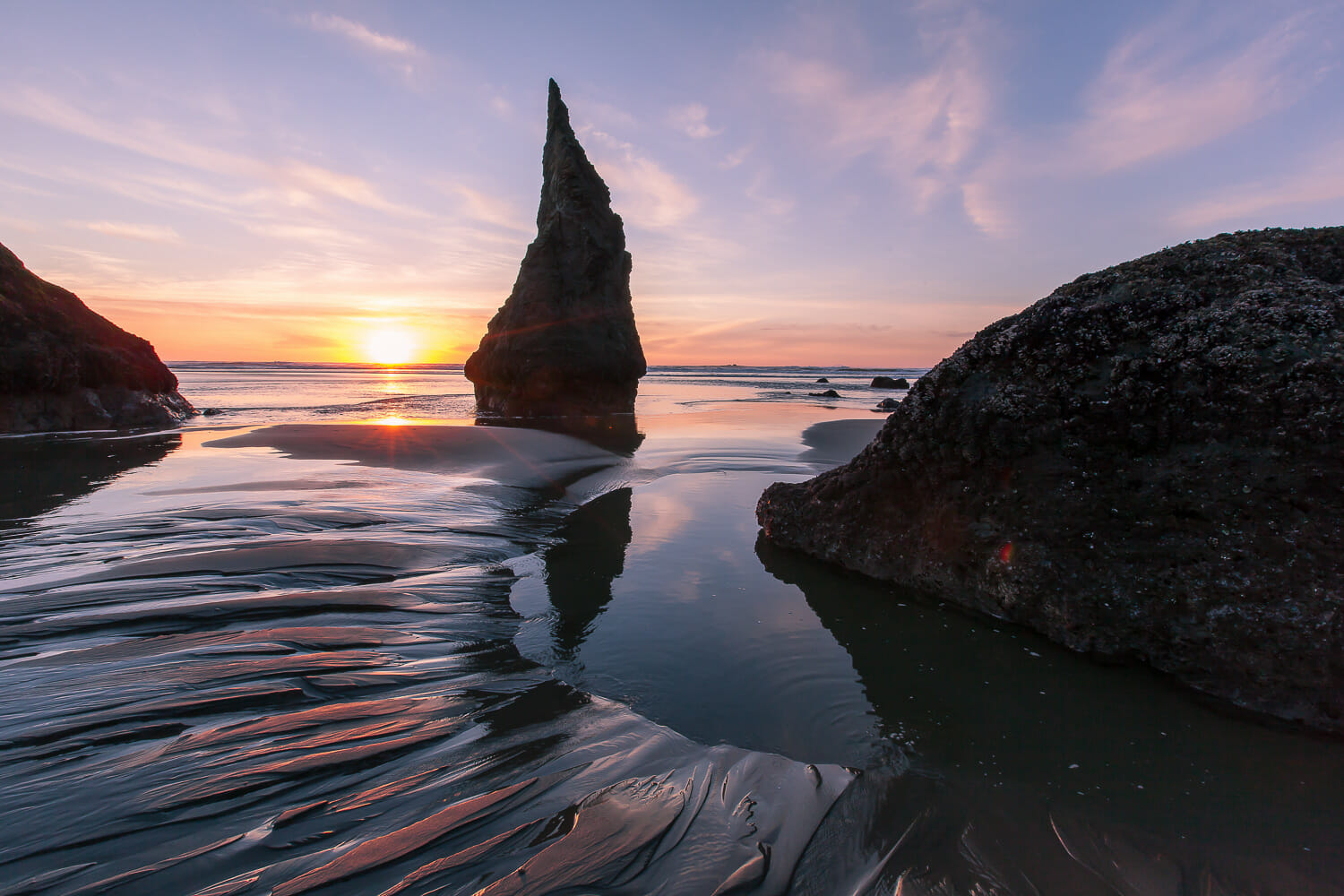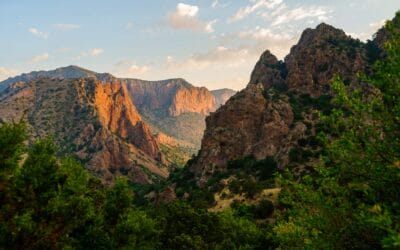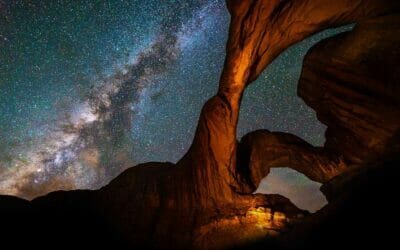Feature photo by Stephen Moehle/Shutterstock
Read Time: 14 minutes
From the stunning rock formations of Cannon Beach to the majestic views along the Samuel H. Boardman Scenic Corridor, the Oregon coast is a paradise for nature photographers looking for an endless array of opportunities for capturing breathtaking photos.
Whether you're more of a forest flora type or see yourself as a sealife scene seeker, the Oregon coast offers something for shutterbugs of all types!
What to wear
The coastal climate is known for its unpredictable nature, with the possibility of experiencing sunshine, rain, and gusty winds all within one day – sometimes within the same hour!
Layering is essential to stay warm, dry, and comfortable during your adventure.
Start with moisture-wicking base layers to keep you dry, followed by insulating mid-layers like fleece or lightweight down jackets for warmth. Finish with a waterproof and windproof outer shell to protect you from the elements.
Clothing checklist:
- a sturdy pair of waterproof hiking
- boots with good traction
- rubber boots if you plan to be on the shoreline
- a wool hat
- a set of warm gloves
- an extra pair of socks
We list a few of our top recommendations for rain gear, boots and other clothes for outdoor photographers in this gift guide (which makes a handy wishlist if anyone asks you what you want for a birthday or holiday!)
Photo: Nagel Photography/Shutterstock
Consider both what you want to photograph – whether landscapes or wildlife – and the Oregon coast's ever-changing weather when deciding how to pack.
Photography gear to pack
The diverse landscapes and unpredictable weather conditions require a versatile and reliable gear set-up to help you capture the coastline in all its glory.
Camera and lenses
First and foremost, pack a camera with a weather-sealed body to withstand the coastal mist, rain, and sand.
A versatile zoom lens, such as a 24-70mm or 24-105mm, will be your go-to for capturing sweeping landscapes, while a telephoto lens (e.g., 70-200mm) will come in handy for photographing wildlife from a distance.
Remember to pack a wide-angle lens to emphasize the vastness of the coastal scenes or capture the unique rock formations you'll find up and down the Oregon coast.
Must-Have Accessories
A sturdy, lightweight tripod is essential for long exposure shots, particularly when capturing the motion of waves or creating ethereal images of the shore during sunrise or sunset.
Protecting your gear is crucial in the coastal environment, so invest in a waterproof and sand-resistant camera bag or backpack to keep everything safe and organized.
It's also a good idea to bring along a rain cover for your camera and lens and a microfiber cloth to wipe off any moisture or sand that may accumulate while shooting.
Pack additional essential accessories such as:
- extra batteries
- memory cards
- lens filters
- a remote shutter release or intervalometer for those perfectly timed shots
Photo: Jaymi Heimbuch
The famed Yaquina Bay Bridge in Newport, Oregon at sunrise. The bridge has been guiding travelers over the bay since 1936.
Safety considerations
From slippery rocks to unpredictable waves, the coast can sometimes feel like an obstacle course for photographers.
To navigate safely, consider these tips:
- Sneaker waves are notorious for their sudden surge, catching even the most experienced explorers off guard.
- Always keep an eye on the water and maintain a safe distance from the water's edge.
- Stay informed about the weather and tide schedules to avoid getting caught off-guard by rising waters or sudden storms.
- Equip yourself with sturdy footwear and take extra caution when navigating uneven terrain.
- Carry a whistle, phone, or radio for communication in emergencies.
- Keep a safe distance from wildlife.
By staying vigilant and respecting the capricious nature of the coast, you'll safely capture the breathtaking moments that make this portion of the Pacific Northwest a photographer's paradise.
Our 10 favorite locations to photograph on the Oregon Coast
When it comes to Oregon coast photography, it's tough to choose our favorites.
Over the entire Oregon coast, from Cannon Beach along the north coast to the southern coast traveling along the Samuel H. Boardman Scenic Corridor, photo locations abound along the entire coastline.
In the more isolated areas, you're free from light pollution and able to get great photos — maybe even your best photos! Read on to learn more about some of the most beautiful places and stellar photo spots on the West Coast.
Let's start at the north Oregon coast. Picture heading south from Washington state, crossing the gorgeous Astoria-Megler Bridge. In just about a 30-minute drive, you'll find yourself at the first of the locations on the Oregon Coast – Ecola State Park.
Photo: Wasim Muklashy/Shutterstock
The beach at Ecola State Park on the Oregon coast during autumn.
Ecola State Park
Best for:
Panoramic coastal views, seabirds, tidepools, whale watching, forest hikes, lighthouse views
Why we love it:
Discover the captivating beauty of Ecola State Park, where rugged cliffs embrace the ocean, creating a symphony of nature that beckons photographers to capture its breathtaking moments.
This coastal wonderland, home to diverse wildlife, including deer, elk, eagles, and even migrating whales in the distance, is also a treasure trove of flora, with towering trees and vibrant wildflowers painting the canvas of the forest floor.
The stunning viewpoints, such as the iconic Indian Beach and Crescent Beach, offer spectacular coastline panoramas, providing endless opportunities for awe-inspiring shots.
Photo tips & ideas:
- Explore the secluded Crescent Beach, accessible via a hiking trail from Ecola Point. This picturesque cove offers a serene setting for nature photography, with its sandy beach, tide pools, and rocky outcroppings.
- Hike along the park's scenic trails, such as the Clatsop Loop Trail or the Tillamook Head Trail, and capture the beauty of the coastal rainforest, complete with moss-covered trees, ferns, and babbling creeks.
- Take in the sweeping vistas of the coastline from various viewpoints in Ecola State Park, such as Ecola Point or Indian Beach. These locations offer stunning views of the surrounding coastal landscape.
- Capture images of the historic Tillamook Rock Lighthouse, also known as Terrible Tilly, perched on an isolated rock formation off the coast. This lighthouse adds a touch of intrigue and history to your coastal photography.
Photo: Danita Delimont/Shutterstock
Haystack Rock and the Needles are popular rock formations at Cannon Beach.
Cannon Beach
Best for:
Landscape photography, sea stacks, tide pools, seabirds (including puffins!)
Why we love it:
Immediately south is Cannon Beach, a coastal haven where sandy shores meet lush forests, creating a rich tapestry of colors and textures.
This enchanting landscape offers endless opportunities for photographers to capture the breathtaking coastline, including fascinating sea stacks, tide pools, and dramatic cliffs.
To truly capture the essence of Cannon Beach, make sure to check out Haystack Rock.
This monolithic sea stack stands guard over the shoreline. Stick around until after the sunset to capture photographs of the night sky, as this location is one of the best spots on the Oregon coast to see the Milky Way!
Photo tips & ideas:
- At 235 feet tall, Haystack Rock dominates the shoreline of Cannon Beach. Experiment with different angles and perspectives to highlight its unique shape and grandeur, especially during sunrise or sunset when the light casts a warm glow on the rock.
- Document the trio of smaller sea stacks known as The Needles. These geological features create captivating silhouettes and provide excellent subjects for both wide-angle and long-exposure photography.
- Head to the tide pools around Haystack Rock during low tide. Photograph the fascinating marine life that makes these miniature ecosystems home.
- Focus on the diverse wildlife that inhabits Cannon Beach, including seabirds such as the beloved tufted puffins nesting on Haystack Rock and the playful harbor seals frolicking in the waves. Use a telephoto lens to capture close-up portraits without disturbing the animals.
Photo: Jaymi Heimbuch
The Devil's Punchbowl was formed when two sea caves collapsed.
Devil's Punchbowl
Best for:
Geological formations, dramatic coastline, tide pools, ocean waves
Why we love it:
As you head south, you'll pass through Cape Kiwanda State Park (definitely worth popping off Highway 101 for), then Pacific City and Lincoln City, before reaching our next stop: Devil's Punchbowl.
The centerpiece of Devil's Punchbowl is an awe-inspiring geological formation, a large bowl-shaped cavity carved by the relentless force of the ocean. This natural amphitheater creates a dynamic and visually captivating subject for your photographs.
The area also has a rich array of flora, from windswept coastal grasses to colorful wildflowers. In contrast, coastal trees provide shelter for diverse wildlife. The rocky shoreline teems with marine life, offering endless opportunities to capture intimate portraits of coastal inhabitants.
Photo tips & ideas:
- Check out the awe-inspiring Devil's Punchbowl itself, a large bowl-shaped cavity you can shoot from above or within. The natural amphitheater and surrounding rugged cliffs provide a visually captivating backdrop for your photos.
- Capture the dynamic movement of the ocean as waves crash against the rocky shore and cascade into the punchbowl. Experiment with different shutter speeds to freeze the action or create a sense of motion in your photographs.
- Get a unique view of the area during low tide, when the rocky intertidal zone reveals its often hidden inhabitants, like colorful sea stars, anemones, and crabs.
- Photograph the dramatic coastline during sunrise or sunset, where the interplay of light and shadow creates stunning contrasts and adds depth to your images.
Photo: Jaymi Heimbuch
The iconic lighthouse at Yaquina Head was first lit in 1873, and stands 93 feet tall.
Yaquina Head Outstanding Natural Area
Best for:
Landscape photography, sea birds, raptors, whale watching, tidepool photography, surf photography, lighthouse photography
Why we love it:
It should come as no surprise the Yaquina Head Outstanding Natural Area is, well, outstanding! This remarkable destination along the central Oregon Coast offers visitors a diverse array of natural and cultural experiences.
Its most notable feature, the Yaquina Head Lighthouse, stands majestically as the tallest lighthouse in Oregon, serving as both a historical landmark and an active aid to navigation.
Rivaling the lighthouse as the top feature is Cobble Beach which leads out to rich marine life seen in the tide pools during low tide.
And, what the heck, why not top it all off with epic views of gray whale migration!
Photo tips & ideas:
- Explore the unique Cobble Beach, characterized by its round basalt rocks that create a distinct sound as the waves roll in and out. Capture these fascinating stones, contrasting them with the movement of the ocean.
- Capture images of the historic Yaquina Head Lighthouse. Standing majestically on a basalt headland, the lighthouse was first lit in 1873 and continues to serve as an active navigational aid for vessels along the Pacific coast. The lighthouse is also a great place to get an eye-level view of the impressive colony of nesting common murres who take over the rocks in spring and summer. You'll also likely see Brandt's cormorants, pelagic cormorants, black oystercatchers, bald eagles, peregrine falcons, and more!
- Photograph the breathtaking coastline of dramatic cliffs, rocky shores, and the vast expanse of the Pacific Ocean. Climb to the top of the Lighthouse or walk to easily accessible nearby viewpoints to capture panoramic shots of the stunning sea- and landscapes.
- Document the area's rich flora, from coastal grasses and vibrant wildflowers to hardy shrubs and trees that thrive in the harsh coastal environment. Look for interesting textures, patterns, and colors in the vegetation to create visually engaging compositions.
Photo: Lijuan Guo/Shutterstock
Thor's Well is a highly dangerous location for anyone unfamiliar with tides, swells and the surprising power of small waves. Many photographers have lost gear and been injured here. Use caution, photograph with ocean-savvy buddies, and never turn your back on the water.
Cape Perpetua
Best for:
Landscape photography, sea birds, tidepools, intense ocean waves
Why we love it:
After crossing the iconic Yaquina Bay Bridge, you'll travel about 40 miles south. There you'll find Cape Perpetua.
From the intensity created by the collision of the ocean with the land to the vibrancy of color found in the marine life that thrives in the tidepools to the pristine forests and peaceful streams, Cape Perpetua boasts some of the most unique combinations of nature in the region.
One of our favorite times to visit is at sunset. Set up your tripod to prepare to capture the rich hues of orange, red, and pink that transform the sky into a work of art. Rich with dynamic and fascinating beauty, Cape Perpetua is sure to inspire.
Photo tips & ideas:
- Capture dramatic features like Thor's Well, a natural sinkhole that appears to swallow the ocean during high tide; Spouting Horn, a blowhole that shoots seawater into the air when waves crash into the rocky shore; and Devil's Churn, a narrow inlet where waves collide with the basalt shoreline, creating dramatic splashes and powerful whirlpools. Experiment with different shutter speeds to create unique images showcasing the power and beauty of these natural phenomena.
- Explore the tide pools during low tide and photograph the marine life in these tiny but mighty ecosystems. Look for colorful sea stars, anemones, crabs, and other creatures, using a macro lens to highlight their intricate details and vibrant colors.
- Visit Cape Perpetua Overlook, the highest point accessible by car on the Oregon coast, to capture panoramic views of the coastline and the surrounding forests of towering Sitka spruces and other coastal trees. It's a landscape photographer's dream.
- Experiment with long-exposure techniques to capture the movement of the ocean swells, creating a smooth, ethereal effect that contrasts with the rugged coastline.
Photo: Jaymi Heimbuch
Standing 56 feet tall, Heceta Head lighthouse was first lit in 1894. It is one of the most photographed lighthouses on the Oregon coast.
Heceta Head Lighthouse
Best for:
Landscape photography, seabirds, lighthouse photography, sea lions, forest hiking
Why we love it:
Just a 30-minute drive from Cape Perpetua, you'll find Heceta Head Lighthouse perched high above the rugged Oregon coast, where steep cliffs give way to serene stretches of sand and crashing waves. The area boasts lush coastal forests, teeming with the vibrant flora of ferns and delicate wildflowers.
In addition to its captivating landscapes, Heceta Head is home to abundant wildlife. Seabirds such as cormorants, gulls, and common murres can be spotted nesting on the nearby cliffs, while sea lions frolic in the waters below. The surrounding forests provide refuge for deer and other woodland creatures, adding to the area's rich biodiversity.
Photo tips & ideas:
- Capture the picturesque Heceta Head Lighthouse, perched atop a dramatic cliff. While sunrise or sunset shots are always a sure thing, why not take advantage of the remote location and dark skies to capture stunning nightscapes?
- Hike to the top of Heceta Head or check out nearby viewpoints to catch panoramic shots of the stunning landscape, encompassing the lighthouse, coastline, and ocean.
- Discover the enchanting Hobbit Trail, a winding path through the dense coastal forest that leads to a secluded beach. Capture the magical atmosphere of this lush, moss-covered environment and the hidden beach it reveals.
- Explore the beautiful Devil's Elbow Beach, located at the base of Heceta Head. Capture the contrast between the dramatic skies, rocky outcroppings, and tumbling waves, creating dynamic compositions that showcase the diverse coastal landscape.
Photo: TSLPhoto/Shutterstock
The Oregon Dunes provides a plethora of lines, curves, textures and contrasting colors.
Oregon Dunes
Best for:
Sand dunes, sunrise and sunset views, recreation, ecosystem variation, hiking trails
Why we love it:
As we make our way farther south, the next spot for unique Oregon Coast photos we'll come to is the Oregon Dunes National Recreation Area.
Boasting an extraordinary landscape characterized by towering sand dunes that stretch for miles, the area has a surreal, otherworldly atmosphere.
These ever-changing dunes are interspersed with serene coastal forests, wetlands, and estuaries, providing photographers with a rich tapestry of visual inspiration.
The area is teeming with flora and fauna, including various bird species, such as the snowy plover, which relies on the dunes for nesting and breeding. At the same time, the coastal forests provide a sanctuary for deer, bears, owls, and other woodland wildlife.
Efforts to protect delicate habitats, restore native vegetation, and manage invasive species can be captured through photography, helping to raise awareness about the importance of protecting this unique ecosystem.
Photo tips & ideas:
- Capture the vast expanse of rolling sand dunes stretching 40 miles along the coast. Watch for interesting patterns and textures created by the wind-sculpted sand. Use a wide-angle lens to capture the vast expanse of the dunes.
- Photograph the breathtaking colors and dramatic shadows on the dunes during sunrise or sunset. These golden hours provide the perfect lighting conditions to accentuate the contours and contrasts of the sand dunes.
- Document the diverse coastal environments within the recreation area, capturing the area's unique flora, such as coastal grasses, wildflowers, and hardy shrubs that thrive in the harsh dune environment.
- Hike atop the dunes to capture panoramic shots of the sweeping landscape encompassing the dunes, coastline, and surrounding forests.
Photo: Manuela Durson/Shutterstock
The drama that unfolds at Shore Acres during a big swell is an experience not to be missed!
Shore Acres State Park
Best for:
Landscape photography, formal gardens, secluded coves, dramatic waves
Why we love it:
Just south of Coos Bay is Shore Acres State Park, a fascinating juxtaposition of natural landscapes with formal gardens, offering visitors a diverse experience in a single location.
The natural environment features dramatic cliffs, rocky shores, and secluded coves that epitomize the rugged beauty of the Oregon coast.
In contrast, the formal gardens showcase meticulously maintained landscapes with vibrant flowers, lush green lawns, and tranquil ponds, providing a serene and idyllic setting for leisurely exploration.
This unique variation between the wild coastal landscape and the manicured gardens makes Shore Acres State Park a captivating destination. And, while you're there, make sure to check out Cape Arago State Park, just a few minutes away.
Photo tips & ideas:
- Discover stunning compositions at the picturesque Simpson Beach, a secluded cove nestled below the park's cliffs. Capture the contrast between the sandy shoreline, rugged rocks, and roaring surf, creating dynamic compositions that showcase the diverse coastal landscape.
- Document the area's rich flora, from the vibrant blooms in the formal gardens to the thriving hardy coastal shrubs and trees.
- Hike along the cliffs to capture panoramic shots of the stunning landscape, encompassing the gardens, shoreline, and secluded coves.
- Visit during stormy weather (while keeping safety in mind!) to capture the dramatic waves crashing against the cliffs and rocky coastline during huge swells. Use a fast shutter speed to freeze the action and showcase the power of the ocean.
Photo: Thomas Elsnab/Shutterstock
Millennia of erosion have turned Bandon Beach into a landscape photographers' playground.
Bandon Beach
Best for:
Landscape photography, sea stacks, nesting seabirds, tide pools, rugged coastline
Why we love it:
With its breathtaking seascapes and diverse ecosystems, Bandon Beach offers a spectacular canvas of unique geological features and a variety of flora and fauna.
Its dramatic sea stacks rising majestically from the shoreline create a striking visual contrast against the crashing waves, while the beach's vast stretches of sand are adorned with intricate patterns sculpted by the wind and tide.
The area is also home to a rich array of coastal grasses and vibrant wildflowers, as well as hardy shrubs and trees. Embrace the enchanting beauty of Bandon Beach, and let your lens tell the story of this coastal paradise.
Photo tips & ideas:
- Capture Face Rock, a sea stack resembling a human face, Wizard's Hat, a cone-shaped rock formation, and other formations that line Bandon Beach. Experiment with different angles and perspectives to emphasize their unique shapes and textures.
- Walk on the Bandon Boardwalk to capture panoramic shots of the stunning coastline, sea stacks, and the ocean.
- Visit the nearby Coquille River Lighthouse, situated at the mouth of the Coquille River, and capture its historic charm and architectural beauty against the backdrop of the ocean and surrounding landscape.
- Photograph the wide stretches of sandy beaches, tide pools, and dramatic cliffs. Allow the interplay of light and shadow at different points of the day to create visual curiosity within your images.
Photo: Michal Balada/Shutterstock
Plan to spend a few days exploring the dramatic vistas along this stretch of the coast.
Samuel H. Boardman Scenic Corridor
Best for:
Landscape photography, sea birds, geological features, secluded beaches, panoramic viewpoints
Why we love it:
At long last, we reach the 12 miles of highway between Brookings and Gold Beach, the Samuel H. Boardman Scenic Corridor, which stands out as one of the most stunning routes in the US.
This rugged panorama offers photographers an unrivaled opportunity to visit numerous Oregon Coast photography locations to capture the majestic beauty of the coastal Pacific Northwest.
From the breathtaking coastline and its secluded beaches to mesmerizing geological features characterized by natural arches, dramatic crags and cliffs, and sea stacks to the western gull, bald eagle, and common murres that call the area home, the Boardman Scenic Area is truly a sight to behold!
Photo tips & ideas:
- Capture the stunning Arch Rock, a natural rock formation carved by the ocean waves. Frame your shot to include the surrounding coastline or focus on the arch itself, highlighting its unique shape.
- Document the numerous sea stacks (such as the one at Whaleshead Beach!), unique rock formations, natural bridges, and small islands that dot the shoreline. These geological features create captivating silhouettes and provide fascinating subjects for long-exposure photography.
- Be sure to check out the hidden gem of Secret Beach, with its picturesque cove, cascading waterfall, and tide pools teeming with marine life. This secluded spot offers an idyllic setting to snap an Oregon Coast photo or two.
- Hike the Indian Sands Trail (a challenging but relatively short trail) or hike to various viewpoints along the scenic corridor, such as the Thomas Creek Bridge or Cape Ferrelo, and on sunny days capture panoramic views of the coastline, ocean, and surrounding forests.
Final notes before you hit the road!
The Oregon Coast offers photographers an unparalleled opportunity to immerse themselves in a diverse array of breathtaking environments.
As you venture along this captivating coastline, remember to dress appropriately for the unpredictable weather, pack versatile gear to capture the ever-changing scenes, and most importantly, take the time to truly appreciate the natural wonders surrounding you.
By embracing the challenges and rewards of nature photography on the Oregon Coast, you'll walk away with stunning images and unforgettable memories of your journey through the Pacific Northwest's most picturesque destinations.

